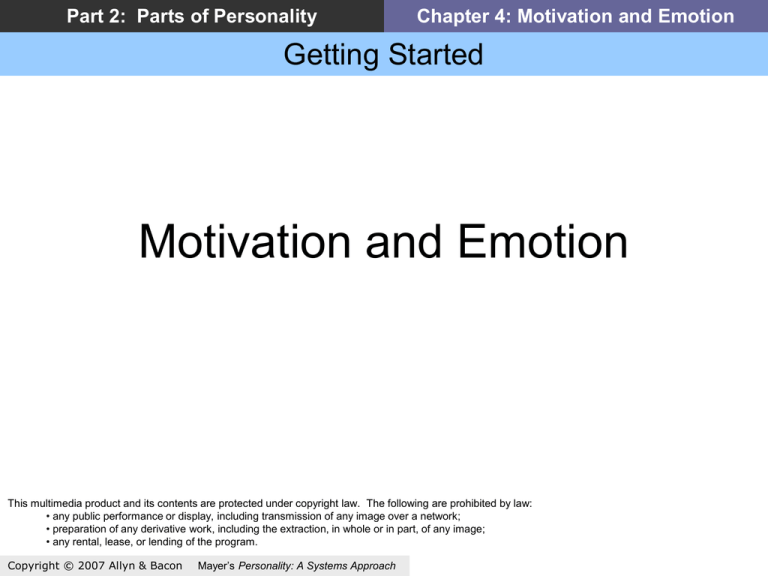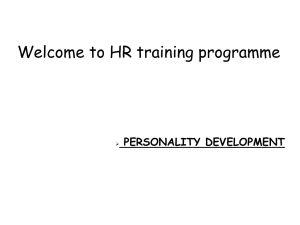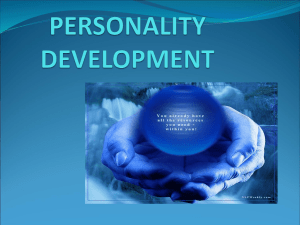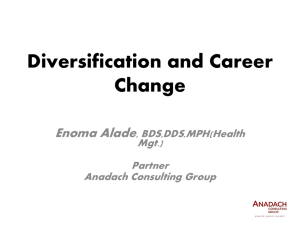
Part 2: Parts of Personality
Chapter 4: Motivation and Emotion
Getting Started
Motivation and Emotion
This multimedia product and its contents are protected under copyright law. The following are prohibited by law:
• any public performance or display, including transmission of any image over a network;
• preparation of any derivative work, including the extraction, in whole or in part, of any image;
• any rental, lease, or lending of the program.
Copyright © 2007 Allyn & Bacon
Mayer’s Personality: A Systems Approach
Part 2: Parts of Personality
Chapter 4: Motivation and Emotion
Getting Started
Main Topics
• What are motives and how can they be
measured?
• How are motives expressed?
• What are emotions and why are they
important
• What are emotional traits and how are
they expressed?
• What are happy people like?
Copyright © 2007 Allyn & Bacon
Mayer’s Personality: A Systems Approach
Part 2: Parts of Personality
Chapter 4: Motivation and Emotion
Getting Started
What Are Motives, Instincts, Needs?
• Instincts – Innate, preprogrammed, biological urge, satisfied by a
simple action
– Freud believed all human motives could be described roughly as falling
categories of
• Sex
• Aggression
– Most other theorists of the time also were instinct theorists
• Motives – Basic biologically-based needs of the organism to behave
in a particular way. Henry Murray Developed a long list of 20 or so.
–
–
–
–
–
Inanimate objects n Acquisition, n Order
Ambition n Achievement, n Recognition
Superiority: n Inviolacy, n Defendance
Sado-Masochism: n Aggression, n Abasement
Affection: n Affliation, n Rejection
Copyright © 2007 Allyn & Bacon
Mayer’s Personality: A Systems Approach
Part 2: Parts of Personality
Chapter 4: Motivation and Emotion
What Are Motives and How Can They Be Measured?
Projective Measures of Motives
• Projective Measures – The presence of an
ambiguous stimulus to which an individual
must respond.
• As a person constructs a story to the
stimulus, portions of his or her style of
thinking – as well a motives – are
expressed and can be measured.
© Copyright 2006 Allyn & Bacon
Mayer’s Personality: A Systems Approach
Part 2: Parts of Personality
Chapter 4: Motivation and Emotion
What Are Motives and How Can They Be Measured?
Projective Measures of Motives
• Thematic Apperception Test (TAT)
• Procedure: Participant is asked to tell a
story about a picture:
– How did it begin?
– What is happening now?
– How will it end?
© Copyright 2006 Allyn & Bacon
Mayer’s Personality: A Systems Approach
Part 2: Parts of Personality
Chapter 4: Motivation and Emotion
What Are Motives and How Can They Be Measured?
Projective Testing:
The TAT
• Tell a story…
• What happened to
bring this about?
• What is going on
now?
• What will happen
next?
© Copyright 2006 Allyn & Bacon
Mayer’s Personality: A Systems Approach
Part 2: Parts of Personality
Chapter 4: Motivation and Emotion
What Are Motives and How Can They Be Measured?
Projective Testing: The TAT
© Copyright 2006 Allyn & Bacon
Mayer’s Personality: A Systems Approach
Part 2: Parts of Personality
Chapter 4: Motivation and Emotion
What Are Motives and How Can They Be Measured?
(Informally) Score Your Own TAT!
N. Achievement
•Meeting
standards of
excellence
•Unique
attainments
•Commitment to
goals
© Copyright 2006 Allyn & Bacon
N. Power
•Controlling
others
•Attempts to
heighten their
influence
•Protection of
others
Mayer’s Personality: A Systems Approach
N. Affiliation
•Maintaining
positive
relationships
with others
•Repairing
relationships
Part 2: Parts of Personality
Chapter 4: Motivation and Emotion
What Are Motives and How Can They Be Measured?
Self-Report: How Honest Are People?
•
•
•
•
•
Are you ambitious?
Do you seek excellence in your work?
Do you prefer to do nothing?
Are you motivated by revenge?
Are you interested in having sexual
relations whenever you can?
© Copyright 2006 Allyn & Bacon
Mayer’s Personality: A Systems Approach
Part 2: Parts of Personality
Chapter 4: Motivation and Emotion
What Are Motives and How Can They Be Measured?
Self-Report: Factor Findings
Cattell’s factor studies:
*Fear avoidance
*Sex
*Assertiveness
*Narcissism
*Sadism
*Achieving
© Copyright 2006 Allyn & Bacon
Mayer’s Personality: A Systems Approach
Part 2: Parts of Personality
Chapter 4: Motivation and Emotion
What Are Motives and How Can They Be Measured?
Forced-Choice Scale Design (Edwards)
• Forced choice, with item selection matched for social
desirability:
• Edwards Personal Preference Inventory (Murray’s
Needs)
• Model Item:
A. Do you prefer to B. Would you
be lazy sometimes, describe yourself as
and just do nothing? seeking revenge
against those who
injure you?
© Copyright 2006 Allyn & Bacon
Mayer’s Personality: A Systems Approach
Part 2: Parts of Personality
Chapter 4: Motivation and Emotion
What Are Motives and How Can They Be Measured?
Motivation: What Does It Influence?
N for Achievement
N for Power
N for Affiliation
Prefer tasks of
moderate difficulty
Direct behavior of
others: executives,
psychologists,
teachers, journalists,
clergy
Spend more time with
others; write more
letters
Get higher grades only Express extreme
in courses relevant to
opinions on matters to
goals
get visibility; obtain
desired possessions
Sympathetic and
accommodating
More involved in
occupations and
upwardly mobile
If intimacy, more
popular, better
adjusted
© Copyright 2006 Allyn & Bacon
Build alliances; but not
necessarily well-liked
Mayer’s Personality: A Systems Approach
Part 2: Parts of Personality
Chapter 4: Motivation and Emotion
What Are Emotions and Why Are They Important?
From Motives to Emotion
• There can be direct connections: e.g.,
anger often accompanies aggression
• Happiness and joining others
• Emotion can amplify motives: e.g.,
happiness can amplify altruism. (Silvan
Tomkins)
© Copyright 2006 Allyn & Bacon
Mayer’s Personality: A Systems Approach
Part 2: Parts of Personality
Chapter 4: Motivation and Emotion
What Are Emotions and Why Are They Important?
From Motives to Emotion
Robert Plutchik’s Emotion-Motive Connections
Emotion
Motive
Function
Trait
Fear
Escaping
Protection
Timid
Anger
Attacking
Destruction
Quarrelsome
Joy
Mating
Reproduction Sociable
© Copyright 2006 Allyn & Bacon
Mayer’s Personality: A Systems Approach
Part 2: Parts of Personality
Chapter 4: Motivation and Emotion
What Are Emotions and Why Are They Important?
Emotions as Evolved Signal System
• Darwin & the evolution of
emotions
• Saw commonalities in
facial and other emotional
expressions across
species
• Harbor Seals and
Chimpanzees mouth
feeding
© Copyright 2006 Allyn & Bacon
Mayer’s Personality: A Systems Approach
Part 2: Parts of Personality
Chapter 4: Motivation and Emotion
What Are Emotions and Why Are They Important?
Emotions as Evolved Signal System
• Darwin & the evolution of
emotions
• Saw commonalities in
facial and other
emotional expressions
across species
• Anger in the cat and dog
© Copyright 2006 Allyn & Bacon
Mayer’s Personality: A Systems Approach
Part 2: Parts of Personality
Chapter 4: Motivation and Emotion
What Are Emotions and Why Are They Important?
Emotions as Evolved Signal
System
The brain is designed to
connect basic
emotions with basic
facial expressions
© Copyright 2006 Allyn & Bacon
Mayer’s Personality: A Systems Approach
Part 2: Parts of Personality
Chapter 4: Motivation and Emotion
What Are Emotions and Why Are They Important?
Universality of Facial Expressions
Percent Agreement as to Facial Expression in Developed Nations
Happiness
Japan
87
Brazil
97
Chile
90
U.S.
97
Fear
Surprise
Anger
Disgust
71
87
63
82
77
82
82
86
78
88
76
85
88
91
69
82
Sadness
74
82
90
73
© Copyright 2006 Allyn & Bacon
Mayer’s Personality: A Systems Approach
Part 2: Parts of Personality
Chapter 4: Motivation and Emotion
What Are Emotions and Why Are They Important?
Universality of Facial Expressions
Emerging, pre-literate societies
• Tell a story: “She is sitting in a house with
no axe, or bow. A pig is standing in the
door looking at her and won’t move…”
• Agreement equally high as in Western
nations
© Copyright 2006 Allyn & Bacon
Mayer’s Personality: A Systems Approach
Part 2: Parts of Personality
Chapter 4: Motivation and Emotion
What Are Emotional Traits and How… Expressed?
Measuring Emotional States
• Self report is king!
• Psychophysiology secondary
• Mood and emotion are often used
synonymously for emotional experience
© Copyright 2006 Allyn & Bacon
Mayer’s Personality: A Systems Approach
Part 2: Parts of Personality
Chapter 4: Motivation and Emotion
What Are Emotional Traits and How… Expressed?
Background on Measurement
• Vincent Nowlis was a researcher for drug
companies
• Developed mood scale
• Thought there were eight to twelve factors
for mood
• Using more modern approaches, two
dimensions become evident
© Copyright 2006 Allyn & Bacon
Mayer’s Personality: A Systems Approach
Part 2: Parts of Personality
Chapter 4: Motivation and Emotion
What Are Emotional Traits and How… Expressed?
Background on Measuring Emotion
Russell’s
Mood
Circumplex
© Copyright 2006 Allyn & Bacon
Mayer’s Personality: A Systems Approach
Part 2: Parts of Personality
Chapter 4: Motivation and Emotion
What Are Emotional Traits and How… Expressed?
Background on Measuring Emotions
• Emotions are momentary…or are they?
• Emotions and relation to personality…
© Copyright 2006 Allyn & Bacon
Mayer’s Personality: A Systems Approach
Part 2: Parts of Personality
Chapter 4: Motivation and Emotion
What Are Emotional Traits and How… Expressed?
Background on Measuring
Personality
•
•
•
•
Hans Eysenck
Wanted to be a physicist
Developed psychological scales
Sample questions
– “I prefer making friends to being alone”
– “I am sometimes tired, sometimes bubbling with
energy, for no apparent reason.”
© Copyright 2006 Allyn & Bacon
Mayer’s Personality: A Systems Approach
Part 2: Parts of Personality
Chapter 4: Motivation and Emotion
What Are Emotional Traits and How… Expressed?
Background on Measuring Personality
• Eysenck’s 2dimensional model of
personality is based
on factor analysis
• Personality traits are
arranged amidst the
two dimensions
Stable
Thoughtful
Talkative
Reliable
Easygoing
Introverted
Extraverted
Rigid
Restless
Sober
Aggressive
Unstable
© Copyright 2006 Allyn & Bacon
Mayer’s Personality: A Systems Approach
Part 2: Parts of Personality
Chapter 4: Motivation and Emotion
What Are Emotional Traits and How… Expressed?
Unification with Observationism
•
•
•
•
Sanguine
Choleric
Melancholic
Phlegmatic
© Copyright 2006 Allyn & Bacon
Mayer’s Personality: A Systems Approach
Part 2: Parts of Personality
Chapter 4: Motivation and Emotion
What Are Emotional Traits and How… Expressed?
Comparison of States and Traits
Stable
Thoughtful
Talkative
Reliable
Easygoing
Introverted
Extraverted
Rigid
Restless
Sober
Aggressive
Unstable
© Copyright 2006 Allyn & Bacon
Mayer’s Personality: A Systems Approach
Part 2: Parts of Personality
Chapter 4: Motivation and Emotion
What Are Emotional Traits and How… Expressed?
Conclusions
• Many traditional “personality traits” reflect a two
dimensional structure.
• Many moods reflect a two dimensional structure
• The personality traits and the mood traits
correspond, when they are rotated
–
–
–
–
Extroversion = arousal
Introversion = calmness
Neuroticism = unpleasantness
Emotional Stability = pleasantness
© Copyright 2006 Allyn & Bacon
Mayer’s Personality: A Systems Approach
Part 2: Parts of Personality
Chapter 4: Motivation and Emotion
What Are Happy People Like?
A Study of the Happiest Students
• Diener and Seligman screened 222 college
stduents
• Only the 24 happiest students were selected
• They scored highest on measures of well-being
• They had consistently happy moods over a 51
day period
• They had low “negative” moods over the same
period
© Copyright 2006 Allyn & Bacon
Mayer’s Personality: A Systems Approach
Part 2: Parts of Personality
Chapter 4: Motivation and Emotion
What Are Happy People Like?
Results from the Study
•
•
•
•
•
The same as others...
Perceived money they
had
Their grades
Conscientiousness
Objective physical
appearance
Time spent in various
activities (TV, religious
observance)
© Copyright 2006 Allyn & Bacon
Mayer’s Personality: A Systems Approach
•
•
•
•
•
Different from others…
Highly satisfied with lives
Nearly never thought
about suicide
Recall many more happy
events
Experienced more happy
events every day
Had good quality
relationships with family
and friends
Part 2: Parts of Personality
Chapter 4: Motivation and Emotion
What Are Happy People Like?
~end of Chapter 4~
© Copyright 2006 Allyn & Bacon
Mayer’s Personality: A Systems Approach










